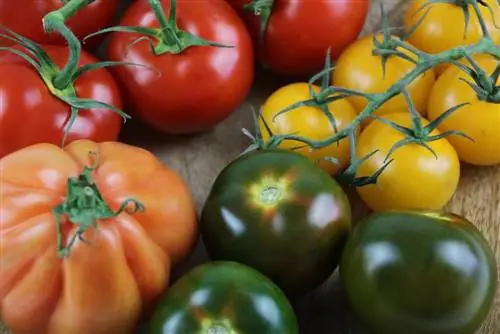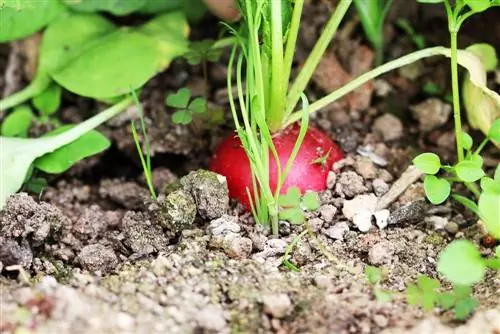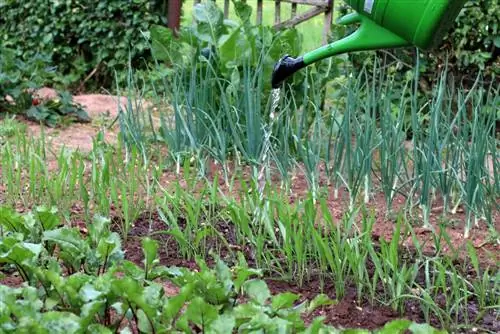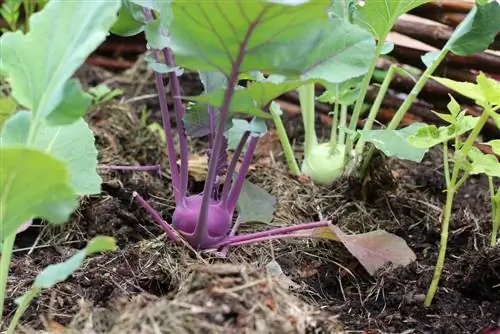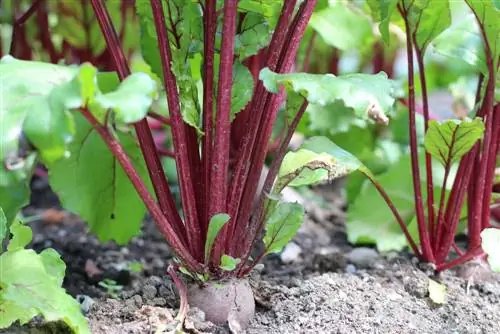- Author admin [email protected].
- Public 2023-12-17 03:39.
- Last modified 2025-06-01 06:48.
A vegetable garden is becoming more and more the central point of garden design. From sowing to harvest, the development of the plants and the ripening process of the fruits can be followed. The warming rays of sunshine in summer not only allow vegetables to ripen optimally, they also ensure that each type of vegetable contains many useful ingredients. Depending on the variety, fresh, crunchy vegetables from the garden are a real taste experience either raw or prepared.
Popular varieties
There are many types of summer vegetables that you can easily grow in your home garden with more or less effort. These include both local and Mediterranean varieties as so-called fruit, stem, tuber or leafy vegetables.
Fruit vegetables
Tomatoes
The tomato is undoubtedly one of the most famous and sought-after vegetables. The fruits, which are red, yellow or green depending on the variety, can be eaten raw, dried or cooked. You can start sowing indoors as early as February. Depending on the variety, the harvest time begins around June and ends before the first frost in October. Particular attention should be paid to avoiding brown rot when it comes to tomatoes. Good plant neighbors include cucumbers, lettuce or lamb's lettuce, radishes, leeks, carrots, celery, zucchini and strawberries. However, you should avoid proximity to peas, bush beans, potatoes, radishes and runner beans.
Cucumbers
Cucumbers belong to the pumpkin family and consist of around 97% water. They differ primarily in size, shape and type of cultivation, rather than in taste. There are long cucumbers, mainly for greenhouse cultivation, and small, aromatic mini cucumbers that are very suitable for outdoor cultivation. What all varieties need are warm and wind-protected locations. Cucumbers are so-called heavy feeders and need to be well supplied with nutrients right from the start. They don't all ripen at once, but gradually. They should preferably be grown next to cabbage, tomatoes or radishes. Cucumbers can be used fresh in salads, used for dipping, and pickled as mustard or pickles.
New potatoes
Home-grown and harvested potatoes are a real treat and cannot be compared with those from the supermarket. As the name suggests, early potatoes are early ripening potato varieties.
- Lay new potatoes between March and May depending on the weather and temperature
- Protect the fresh green of the plants from frost initially with fleece
- Harvest possible during flowering around the beginning of June
- Early potatoes do not store as well as late varieties
- Therefore only harvest as needed
- Leave the remaining potatoes in the ground
- For potatoes, always follow the crop rotation in the form of a four-year cultivation break
Peppers
Peppers are an excellent summer vegetable. In contrast to longer and narrower spiced peppers, sweet peppers are rather thick and rounded, sometimes tapering, with a mild, almost sweet taste. When unripe, all varieties are green. As they ripen, they turn yellow, red or orange, depending on the variety. They only develop their full aroma when fully ripe. The pods have a variety of uses in summer cuisine, be it raw in salads, stuffed, grilled or as an ingredient in Mediterranean dishes. Peppers grow well alongside cabbage, tomatoes, carrots and cucumbers. However, it is not advisable to be close to peas, beetroot and fennel.
Zucchini
Like the cucumber, the zucchini is also a pumpkin plant. The most common is the elongated, green zucchini. There are also rounded varieties and fruits with a yellow color. Yellow zucchini are usually thinner-skinned and milder in taste than their green relatives. They can be grown indoors from mid-April or sown directly from mid-May and harvested around 8 weeks later, depending on the variety. It is best to harvest elongated zucchini when they are 15 - 20 cm in size, then they are at their best. This means that new fruits can quickly form again. Even though they are generally rather neutral in taste, zucchini are a popular and varied ingredient in the kitchen. They can be eaten raw, stuffed, baked, grilled and even made into cakes. Zucchini is one of the few vegetables where the flowers are also a delicacy.
Eggplant
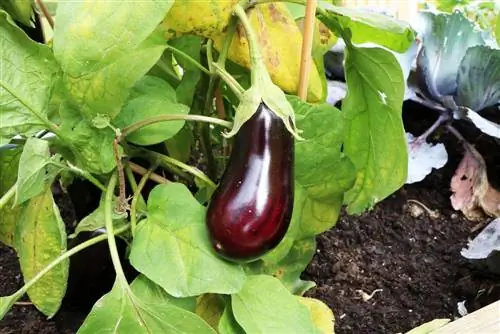
Aubergines are mainly found in Mediterranean cuisine. The best known are the elongated aubergine-colored varieties, although there are also rounded varieties and those with light skin.
- Aubergines need a lot of heat
- Therefore, it is best to grow in greenhouse conditions
- Grow indoors from February and plant in the greenhouse from the end of April
- Outdoor planting only from mid-May, not before the Ice Saints
- Early potatoes are ready for harvest between the end of July and the beginning of August
- Peel of ripe fruit gives way under slight pressure
- Ripe eggplants have an intense dark purple color
- They should be white inside and no longer greenish
Aubergines don't all ripen at the same time. The last ones are ready for harvest around October. Although they are not suitable for raw consumption, they can, for example, be grilled or used in casseroles and what would a ratatouille or a moussaka be without eggplant.
French beans
Beans are very diverse and particularly productive. In home gardens, mainly low-growing bush beans and climbing pole beans are grown, although the variety of varieties is much larger. Cultivation is extremely easy and the first beans can be harvested just two months after sowing. The seeds are sown from mid-May and harvested from around mid-July. They are the ideal partner for a mixed culture with cabbage, lettuce, potatoes, celery and radishes. Bad neighbors are peas, leeks, fennel and garlic. Beans are not only delicious as a stew. They are a delicious side dish to many main dishes and can be pickled in a sweet and sour way.
Peas / sugar snap peas
The pea is one of the oldest vegetables. Among the numerous varieties, the delicate sugar snap peas are particularly popular. Here you can eat not just the peas inside, but the entire shell. Of course, peas taste best fresh from the vine. Cultivation is uncomplicated. Depending on the variety, it can be sown from March/April and harvested from around June. If you sow again every 3-4 weeks, you will have a harvest that lasts well into the summer. Peas grow well alongside cucumbers, cabbage, carrots, radishes, lettuce, zucchini and radishes. Bad plant neighbors include bush and pole beans, potatoes, leeks and tomatoes.
Tip:
After the last harvest, you should not pull the plants out of the ground, but leave the roots in the ground, because they enrich the soil with nitrogen, which benefits other crops.
tuber vegetables
Kohlrabi
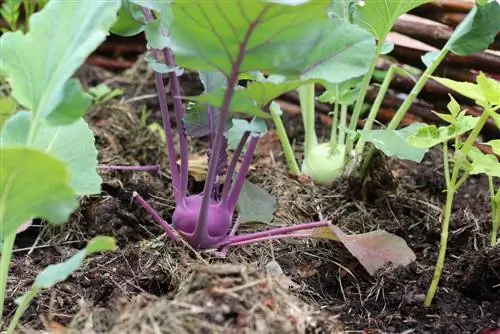
Kohlrabi is also a popular summer vegetable and delicious to boot. Raw it is a taste experience and a real all-rounder in the kitchen, be it in salads, casseroles or as a vegetable side dish. The leaves have a particularly high nutrient content and can be processed. Kohlrabi can be grown early from mid-March and planted from mid-April. For a longer harvest, subsequent sowings are recommended. After 8-12 weeks depending on the variety, the delicious tubers are ready to harvest. You shouldn't wait too long to harvest, because if harvested too late, kohlrabi quickly become woody and inedible. Young kohlrabi are the most tender and tasty. They thrive particularly well next to peas, bush and runner beans, cucumbers, potatoes, lettuce, leeks, spinach, celery and tomatoes.
Radish
Hardly any other type of vegetable is as easy to grow as radishes. Home-grown radishes have a very fine spiciness and impress with their tender flesh.
- They can be sown from spring to August
- Complete culture period is 6-8 weeks
- Suitable as pre-, intermediate and post-culture of other types of vegetables
- Crop rotation should be observed
- Do not grow where there were already radishes, cabbage or radishes
- Positive, is close to beans, peas, carrots, tomatoes and lettuce
Radishes can be harvested approximately 21-28 days after sowing. It is best to harvest them when the tubers are 2 - 3 cm in diameter, then they are most aromatic. If you harvest them later, they become woody quickly. Radishes should be eaten fresh or processed if possible.
cabbage vegetables
Cauliflower
Cauliflower, which is related to broccoli, is a real vitamin bomb and one of the more demanding types of cabbage. It thrives equally well in pots, balcony boxes and in beds. Since cauliflower is a heavy eater, its nutritional requirements are particularly high. Depending on the time of sowing or planting, the snow-white heads can be harvested from June to October, i.e. around 8-12 weeks later. You can tell whether the cauliflower is ripe because the small florets are completely closed. A special feature is the so-called picking cauliflower, an F1 hybrid that forms several side shoots, each with a little head. This means you can harvest fresh cauliflower again and again from July to August. With this vegetable, you should also pay attention to crop rotation and allow a cultivation break of 3-4 years, during which it should not be grown on the same bed.
Tip:
For an intense white color, the head of the cauliflower must be protected from too much sunlight, even if it prefers very sunny locations. The best way to do this is to tie the leaves together over the head of cabbage.
Leafy vegetables
Plucking and cutting salads

The most popular summer vegetables also include crunchy pick and cut salads such as oak leaf lettuce, lollo rossa or lollo bionda. Oak leaf lettuce has red or light green, very tender leaves with a nutty taste. Lollo rossa and Lollo bionda each have red or green, heavily curled leaves that form dense rosettes.
In contrast to lettuces, pick or cut lettuces do not form heads, but are harvested continuously by picking or cutting off the individual leaves from the outside in. Over the course of a season, you can reseed several times, significantly extending the harvest time. Depending on the time of sowing or planting, the first harvest can take place 5-6 weeks later.
Tip:
The shoot axis or the heart leaves should remain untouched so that new leaves can form again.
Iceberg or ice cream salad
The iceberg lettuce, also known to many as ice cream or crash lettuce, develops large heads with crisp leaves. It can also be reseeded again and again throughout the season. Ice cream lettuce can handle a lot of heat without shooting. It can be grown indoors from February and planted in the garden when there is no longer any danger of frost. Like pick and cut salads, iceberg lettuce can be prepared with savory but also sweet and fruity ingredients. It takes around 8-12 weeks until harvest.
Conclusion
Who doesn't want to conjure up or spice up new dishes with fresh vegetables? Especially since home-harvested vegetables are not only delicious, but also he althy. The selection is highest in summer, now is the high season, especially for crunchy fruit vegetables. Even if you don't have a garden, you don't have to go without fresh vegetables, because most summer vegetables can easily be grown in pots on the balcony or terrace.

